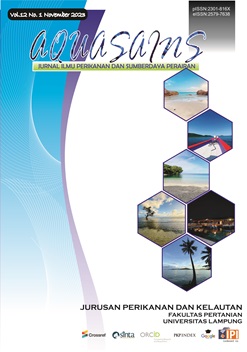EFFECT OF MICROENCAPSULATED Lactobacillus sp. ON CATFISH (Pangasius hypophthalmus) INFECTED WITH Aeromonas sp.
DOI:
https://doi.org/10.23960/aqs.v13i1.p1575-1588 Abstract View: 245
Abstract View: 245
Abstract
The prevention of fish infections caused by Aeromonas sp. bacteria can be achieved using Lactobacillus sp. bacteria. This study aims to identify and analyse the effect of Lactobacillus sp. using the microencapsulation method to treat catfish infected with Aeromonas sp. The identification of Lactobacillus sp. bacteria was conducted through microbiological and molecular tests. After obtaining the test results, the research continued with the application of microencapsulation using the emulsion technique. The impact of this microencapsulation was evaluated on catfish through an experimental approach employing a completely randomised design (CRD), with 10 catfish tested in each experimental aquarium. The study included five treatments, designated as A, B, C, D, and E. Treatment A served as the control, without the administration of Lactobacillus. Treatment B involved the application of Lactobacillus without microencapsulation. Treatments C, D, and E utilised varying doses of Lactobacillus at 0.003, 0.005, and 0.007 g/L, respectively. Each treatment was conducted in triplicate. Microbiological and molecular testing identified encapsulated Lactobacillus sp., specifically Lactobacillus helveticus and Lactobacillus johnsonii. The results indicated that treatment D, comprising a dose of 0.005 g/L of Lactobacillus helveticus and Lactobacillus johnsonii, was the most effective in promoting the healing of catfish infected with Aeromonas hydrophila bacteria.
Keywords: Completely randomized design, bacterial infection mitigation, probiotic bacteria, emulsion technique.
Downloads
References
Bayusetiaji, A., Basuki, F., & Haditomo, A. (2015). Kajian perbedaan konsentrasi larutan garam pada perendaman rgh dan vaksin terhadap kelulushidupan dan pertumbuhan benih ikan lele sangkuriang (Clarias gariepinus). Journal of Aquaculture Management and Technology, 4(4), 1–10.
Blaxhall, P. C., & Daisley, K. W. (1973). A rapid method for the determination of fish serum comparative physiological and biochemical studies. Journal of Fish Biology, 5.
Chatterjee, S., Ghosh, S. K., Mohanty, B. P., & Pradhan, P. K. (2017). Dietary supplementation of probiotic Bacillus coagulans: effects on growth performance, nutrient utilization, immune response, and resistance to aeromonas hydrophila infection in the freshwater fish Labeo rohita (Hamilton). Aquaculture, 467.
Cheng, A. C., Ballantyne, R., Chiu, S. -T., & Liu, C. H. (2023). Microencapsulation of Bacillus subtilis E20 probiotic, a promising approach for the enrichment of intestinal microbiome in white shrimp, Penaeus vannamei. Fishes, 8(5), 264. https://doi.org/10.3390/fishes8050264
Dimitroglou, A., Merrifield, D., Carnevali, O., Picchietti, S., Avella, M., Daniels, C., Derya, G., & Davies, S. (2011). Microbial manipulations to improve fish health and production – A Mediterranean perspective. Fish & Shellfish Immunology, 30(1).
Hoseinifar, S. H., Esteban, M. Á., Cuesta, A., & Sun, Y.-Z. (2015). Probiotics as means of diseases control in aquaculture, a review of current knowledge and future perspectives. Frontiers in Microbiology, 6.
Jayanthi, S., & Arico, Z. (2022). Pengayaan Brachionus plicatilis dengan fortifikasi probiotik sebagai pakan ikan air tawar tinggi nutrisi. Jurnal Jeumpa, 9(2), 795-804.
Kabata. (1985). Parasites and Diseases of Fish Culture in the Tropics. Taylor Francis. London. 318p.
Kurniawan, A. (2012). Penyakit Aku-atik. UBB Press. Bangka Beli-tung. 225 hlm.
Leung, K. Y., & Stevenson, R. M. W. (1988). Tn5-induced proteasedeficient strains of Aeromonas hydrophila with reduced virulence for fish. Infection and Immunity, 56.
Lukistyowati, I., Windarti, & Riauwaty, M. (2007). Analisis hematologi sebagai penentu status kesehatan ikan air tawar di Pekanbaru. Jurnal Akuatika, 2(2).
Lukistyowati, L., & Kurniasih. (2011). Kelulushidupan Ikan mas (Cyprinus carpio L) yang diberi pakan ekstrak bawang putih (Allium sativum) dan diinfeksi Aeromonas hydrophila. Jurnal Perikanan Dan Kelautan, 16(1).
Novita, Setyowati, D. N., & Astriana, B. (2020). Profil darah ikan kakap putih yang diinfeksi bakteri Vibrio sp. dengan pemberian lidah buaya (Aloe vera). Jurnal Perikanan, 10(1), 55–69.
Panigrahi, A., Kiron, V., Satoh, S., Hirono, I., Kobayashi, T., Sugita, H., & Aoki, T. (2007). Immune modulation and expression of cytokine genes in rainbow trout Oncorhynchus mykiss upon probiotic feeding. PubMed Central National Library of Medicine, 31(4).
Rahmawati, A. R., Ulkhaq, M. F., Susanti, D., Kenconojati, H., & Fasya, A. H. (2021). Identifikasi bakteri Aeromonas salmonicida dan Edwardsiella ictalury pada ikan hidup yang akan dilalulintaskan dari Daerah Istimewa Yogyakarta. Journal of Marine and Coastal Science, 10(2).
Ramirez, L. R., Solano, P. R., Alonso, C. S., Guerrero, M. S., Pachero, R. A., Garibay, G. M., & Eslava, C. (2017). Probiotic Lactobacillus strains stimulate the inflammatory response and activate human macrophages. Immunology Research.
Rusli, Amalia, F., & Dwyana, Z. (2018). Potensi bakteri Lactobacillus acidophilus sebagai antidiare dan imunomodulator bioma. Jurnal Biologi Makassar, 3(2).
Supian, E. (2015). Penanggulangan Hama dan Penyakit pada Ikan, Solusi Budidaya Ikan yang Sehat dan Menguntungkan. Pustaka Baru Press.
Umniyatie, S. (2015). Mengenal berbagai macam mikroba patogen pencemar pangan. Jurnal Ilmiah WUNY, 16(6). https://doi.org/10.21831/jwuny.v16i6.4457
Utami, D., Prayitno, S., Hastuti, S., & Santika, A. (2013). Gambaran parameter hematologis pada ikan nila (Oreochromis niloticus) yang diberi vaksin DNA Streptococcus iniae dengan dosis yang berbeda. Journal of Aquaculture Management and Technology, 2(4), 7–20.
Wan, Z., Zhang, X., Jia, X., Qin, Y., Sun, N., Xin, J., Zeng, Y., Jing, B., Fang, J., Pan, K., Zeng, D., & Bai, Y. (2022). Lactobacillus johnsonii YH1136 plays a protective role against endogenous pathogenic bacteria induced intestinal dysfunction by reconstructing gut microbiota in mice exposed at high altitude. Frontiers in Immunology, 13.
Zhang, J., Du, P., Gao, J., Yang, B., & Fang, W. (2012). Preoperative probiotics decrease postoperative infectious complications of colorectal cancer. The American Journal of Clinical Nutrition, 343(3), 199–205. https://doi.org/10.1097/MAJ.0b013e31823aace6
Zhu, Q., Huimin, S., Qiaqia, Z., Lanhua, Y., Xin, W., Yuanyuan, S., Yanglei, Y., Bianfang, L., Yuan, Z., & Xin, L. (2020). Characterization and antibacterial action mode of bacteriocin BMP32r and its application as antimicrobial agent for the therapy of multidrug-resistant bacterial infection. International Journal of Biological Macromolecules, 164.
Downloads
Published
How to Cite
Issue
Section
License
Copyright (c) 2024 Zhafira Putri Kharima, Yuniar Mulyani, Iskandar Iskandar, Roffi Grandiosa Herman

This work is licensed under a Creative Commons Attribution-ShareAlike 4.0 International License.

.png)










